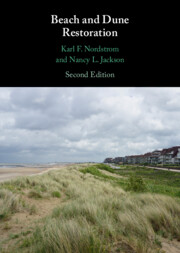Book contents
- Beach and Dune Restoration
- Reviews
- Beach and Dune Restoration
- Copyright page
- Contents
- Contributors
- Preface
- Acknowledgments
- 1 The Need for Restoration
- 2 Beach Nourishment and Impacts
- 3 Dune Building Practices and Impacts
- 4 Restoring Processes, Structure, and Functions
- 5 Altering or Removing Shore Protection Structures
- 6 Options in Spatially Restricted Environments
- 7 Stakeholder Interests, Conflicts, and Cooperation
- 8 A Locally Based Program for Beach and Dune Restoration
- 9 Research Needs
- References
- Index
4 - Restoring Processes, Structure, and Functions
Published online by Cambridge University Press: 09 December 2021
- Beach and Dune Restoration
- Reviews
- Beach and Dune Restoration
- Copyright page
- Contents
- Contributors
- Preface
- Acknowledgments
- 1 The Need for Restoration
- 2 Beach Nourishment and Impacts
- 3 Dune Building Practices and Impacts
- 4 Restoring Processes, Structure, and Functions
- 5 Altering or Removing Shore Protection Structures
- 6 Options in Spatially Restricted Environments
- 7 Stakeholder Interests, Conflicts, and Cooperation
- 8 A Locally Based Program for Beach and Dune Restoration
- 9 Research Needs
- References
- Index
Summary
Chapter 4 discusses restoration of the natural functions of degraded landforms and landforms that provide a limited number of shore protection or recreational values. The case is made to make beach/dune systems more dynamic to allow nature to undergo exchanges of sediment, nutrients, and biota; follow cycles of accretion, erosion, growth, and decay; and retain diversity, complexity, and the ability to deliver ecosystem services. Actions include reestablishing physical habitat characteristics (e.g., overwash areas and slacks), removing invasive species, and reinitiating cycles of growth and decay by reducing vegetation cover or destabilizing surfaces to favor reworking by waves and winds. Many of these actions are most appropriate for landscapes that are usually found within natural preserves and consistent with the regulations governing their management. Issues associated with removing wrack (beach cast), driving on the beach, restoring mined sites, and stabilizing dune fields that are overly mobile are also addressed in this chapter. Restoration actions in intensively developed areas where beach and dune evolution are under severe spatial constraints are addressed in subsequent chapters.
Keywords
- Type
- Chapter
- Information
- Beach and Dune Restoration , pp. 88 - 122Publisher: Cambridge University PressPrint publication year: 2021
- 1
- Cited by



